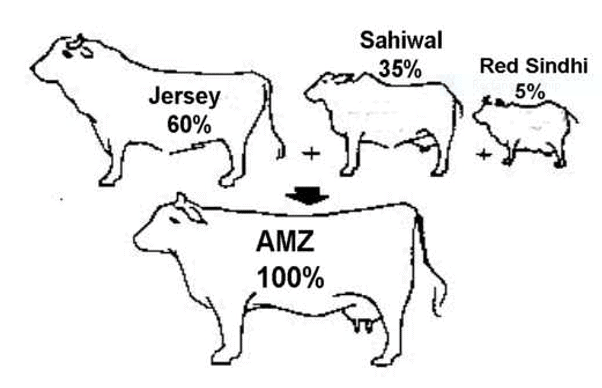
Development of Australian Milking Zebu
Dr. A. SamadCattle native to tropical climate, especially Zebu, are genetically well adapted to climate stress, infections and infestations prevalent in the native area but their productivity is found to be low. In contrast cattle from temperate zones although not suited to tropical climate have better productivity. Through careful breeding however marriage of good characters from both the breeds is possible resulting in ‘synthetic breeds’. This strategy has been employed even in temperate breeds to introduce disease resistance inheritance.
In Australia a similar strategy was employed to develop Australian Milking Zebu (AMZ) that are cross between Jersey and Sahiwal (in earlier stages Red Sindhi was also tried but discontinued in later stages). These experiments were carried out on F. D. McMaster Station of the CSIRO at Badgery’s Creek, New South Wales. The development was carried out in three stages which is depicted in the figure (courtesy FAO).
Stage 1: Since large number of proven Zebu males were not available in the first stage bulls born to better milk producing Sahiwal were used to mate with Jersey cows. The F1 cows were milked in first lactation and males born to top producing females were used for inter se mating. Around 70% of the cows were found to have intense maternal instinct in that when these were weaned from calves failed to yield milk, whereas 30% cows were found to be good milk yielders. Stage 1 continued up to three generations.
The F1 cows were milked in first lactation and males born to top producing females were used for inter se mating. Around 70% of the cows were found to have intense maternal instinct in that when these were weaned from calves failed to yield milk, whereas 30% cows were found to be good milk yielders. Stage 1 continued up to three generations.
Stage 2: In the second stage breeding program was based on progeny testing of young bulls from meritorious dams. The bulls in groups of four were first screened for climate stress for which the bulls first kept in controlled temperature (21oC dry and 18oC wet bulb) and evaluated for rectal temperature, sweating rate, respiration rate, food intake and water. Out of four two better adapted bulls were taken for high temperature exposure (38oC dry and 24oC wet bulb) and further selected bulls were exposed to higher climate stress. Out of 40 bulls 12 bulls were selected for second tick infestation challenge test. The tick challenge test was done in pasture and six bulls having least engorged ticks were then selected for progeny testing program.
The first part of the program heifers for first lactation were available in three years whereas subsequent heifers and later lactation records were recorded for seven years. During the period enough progeny test bulls were ranked for use in third stage of the program. Heritability of milk production was found to be 0.23 to 0.27. Interestingly the even when managed on open grazing under hard conditions the AMZ was found to produce milk similar to Jersey under same conditions (1375 – 1820 kg).
Stage 3: During this stage only sons of sires selected in the progeny testing programs were used for mating top producing females in the nucleus herd. The objective of the third stage of the program is to maintain Indicus blood to 1/8th to 3/8th with bull selection criteria of high production dam, tolerance to heat and resistance to ticks. The first lactation records of the heifers in from stage of the program reveal that their production was similar to Jersey maintained under similar management and climate conditions.
Lesson for India: There are two lessons: (a) If Zebu cows are managed scientifically their productivity in harsh climate would be more or less similar to Taurus breeds and (b) the crossbreeding program needs reviewing by introducing selection of bulls based on dam’s production, tolerance to heat and resistance to ticks and end objective of maintaining 1/8th to 3/8th Zebu blood level.
